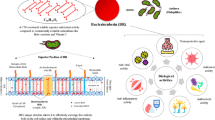Summary
The range of (presumed) polyketide constituents in comatalid crinoids has been extended to include bianthronyls, meso-naphthodianthrones and sulphate esters of various of the polyketides. Several species of fish are deterred from eating food by the inclusion in it of these sulphates at the concentration found in crinoids. Sodium 2-hydroxy-anthraquinone sulphate and anthraquinone-2-suphonate were also active as antifeedants for the species tested.
Similar content being viewed by others
References
R.A. Kent, I.R. Smith and M.D. Sutherland, Aust. J. Chem.23, 2325 (1970); I.R. Smith and M.D. Sutherland, Aust. J. Chem.24, 1487 (1971).
M.D. Sutherland and J.W. Wells, Chemy Ind.1959, 291; M.D. Sutherland and J.W. Wells, Aust. J. Chem.20, 515 (1967); V.H. Powell, M.D. Sutherland and J.W. Wells, Aust. J. Chem.20, 535 (1967).
T.R. Erdman and R.H. Thomson, J. chem. Soc., Perkin Trans.2, 1291 (1972); T. Matsuno, K. Fugitani, S. Takeda, K. Yokota and S. Yoshimizu, Chem. pharm. Bull.20, 1079 (1972).
The trivial name crinemodin is suggested for11 isolated fromComanthus bennetti by G.L. Bartolini, T.R. Erdman and P.J. Scheuer (Tetrahedron29, 3699 (1973)) and by us fromPtilometra australis (Wilton) and from many other crinoid species so that with rhodoptilometrin, it is one of the commonest crinoidal polyketides.
V.H. Powell and M.D. Sutherland, Aust. J. Chem.20, 541 (1967).
R.L.A. Catala, in: Carnival under the Sea, p. 61. N.R. Sicard, Paris 1964; L.H. Hyman, in: The Invertebrates, Vol. IV, p. 101. McGraw-Hill, New York 1955; D.L. Meyer, Bull. marine Sci.23, 244 (1975).
e.g., J.E. Randall, Stud. trop. Oceanogr., Miami5, 665 (1967); R.W. Hiatt and D.W. Strasburg, Ecol. Monogr.30, 65 (1960); R.H. Lowe, J. Linn. Soc. London Zool.;44, 669 (1962).
For the views of H.L. Clark, A.H. Clark and T. Mortensen, see H.B. Fell in: Physiology of Echinodermata, p. 53. Ed. R.A. Boolootian, Interscience, New York 1966.
Exceptions have been observed by Ms J. Marshall of the Australian Museum who has encountered a fish eatingColobometra perspinosa and Mr A. Birtles of the James Cook University of North Queensland who has witnessed attacks onAmphimetra tessellata tessellata (personal communications to J.A.R.).
Author information
Authors and Affiliations
Additional information
Acknowledgments. This author is indebted to the Australian Research Grants Commission for financial support, to Miss A. Clark of the British Museum of Natural History, London, and Ms J. Marshall of the Australian Museum, Sydney, for identifications of crinoid specimens and to Mr C. Lee, Director of the Deception Bay Laboratory of the Qld. Fisheries Service for providing facilities, fish and valuable advice.
Rights and permissions
About this article
Cite this article
Rideout, J.A., Smith, N.B. & Sutherland, M.D. Chemical defense of crinoids by polyketide sulphates. Experientia 35, 1273–1274 (1979). https://doi.org/10.1007/BF01963951
Published:
Issue Date:
DOI: https://doi.org/10.1007/BF01963951




